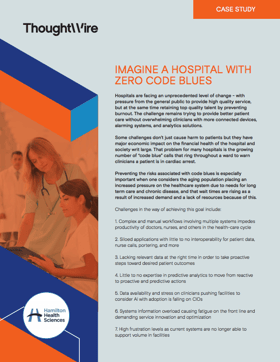As we begin 2019 it’s time to really focus on what matters when it comes to digitally transforming healthcare.
There’s been a lot of investment in software solutions, communication and collaboration platforms, IoT, AI, and the list is endless. Leaders looking to drive results in 2019 may be left wondering how to make sense of the ever-growing list of emerging technology and put their existing data and systems to work.
What many have discovered is that digital transformation for digital transformations sakes is a fool’s errand; claims that AI is disrupting everything from surgeons to nurses is a far cry from the truth. What really matters is addressing the outcomes that will help move the needle for your health system and for that, there is no better framework than the quadruple aim. The quadruple aim categorizes 4 key areas of improvement for a health system:
- Improvements to the patient experience
- Driving better outcomes
- Lowering costs
- Better supporting care teams

This framework is necessary for any evaluation of technology solutions - most especially nascent technology like IoT and AI. If the solution considered is not tackling these 4 outcomes it will not be a worthwhile endeavour for your health system. The growing consensus among healthcare professionals positions the quadruple aim as a requirement, driven by the rising incidences of clinician burnout, worsening patient satisfaction metrics, and the ballooning costs of healthcare.
So how can you use the quadruple aim to jumpstart the journey to better outcomes and digital transformation? Follow the steps below and don’t forget to visit the ThoughtWire booth 1721 at HIMSS 2019 to learn more.
Step 1: Don’t underestimate the data challenge
The biggest barrier to achieving the quadruple aim is data. For most health systems, data resides in many different siloes, from the EMR to billing to facility management. Many of these systems do not talk to one another, or the data and workflows driven are not considered in context of the entire operation. Look for solutions that can operate across the silos and help unlock the potential of real-time data from devices and latent data sitting in systems.
Step 2: Look for opportunities to augment your frontline staff - doctors, nurses and hospital staff
The goal of AI has often been stated as using massive volumes of data to better perform tasks typically reserved for humans - the hypothesis being that increasing computational power and a rise in data creates the perfect environment for machine driven decision making. AI certainly works well for many tasks, but hinders many other ones. AI solutions and decisions that siloes communication, disrupts tacit knowledge, and adds additional work does not support the 4th aim. Instead, better address the quadruple aim by finding solutions that naturally fit into the existing clinical workflows with context-rich data intelligence.
Step 3: Consider both patients and staff as the focal point of technology
By approaching your solution design with a patient and staff first mentality you’re well on your way to making the quadruple aim a foundational framework. In recent years, the number of smart systems, applications, and technology has exploded within the health system, most notably the ubiquitous Electronic Health Record (EHR), yet recent studies suggest that 34% of clinicians are dissatisfied and burnt out. Moreover, this constant screen time has taken away from the “art of care” characterized by more time spent by a patient's bedside, this lack of face time with hospital staff negatively impacts patients satisfaction. Don’t inundate your health system with a myriad of technology that takes doctors and nurses away from caregiving, instead enhance their ability to give care by delivering actionable data at the right moment. For patients looks for technology that removes friction from their patient journey and enhances their experience within and beyond the four walls of the hospital.
Step 4: Think about your health system holistically - don’t forget the buildings in which you operate.
Most health systems have made great strides in digitalization yet one aspect remains disjointed from the larger transformation agenda - the building itself. We spend 87% of our times indoors much of that time is spent in buildings where we work. The built environment itself has become more important to the digital transformation agenda, beginning with industries such as manufacturing and now in healthcare. Building system integration offers data that can have massive impact on operational efficiency and safety within the hospital. Provide hospital staff with alerts when key building assets are offline like elevators, give them wayfinding to get places faster, and help them put wards on lockdown immediately and automatically when an emergency occurs.
We’ll be talking about these topics and more at #HIMSS2019 don’t forget to visit our booth 1721 and schedule a meeting with us to get a 1:1 demo of our Smart Hospital Suite - designed to solve the most pressing problems in health system operations.






